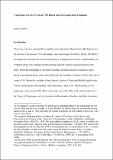Files in this item
Cambridge University Library MS Dd.8.2 and the disappearing fragment
Item metadata
| dc.contributor.author | Luxford, Julian | |
| dc.date.accessioned | 2023-04-21T23:42:07Z | |
| dc.date.available | 2023-04-21T23:42:07Z | |
| dc.date.issued | 2022-04-22 | |
| dc.identifier | 278591239 | |
| dc.identifier | a08a3a9f-bf51-4b25-ad31-2de3a1abe01f | |
| dc.identifier.citation | Luxford , J 2022 , ' Cambridge University Library MS Dd.8.2 and the disappearing fragment ' , Florilegium , vol. 35 , pp. 138-157 . https://doi.org/10.3138/flor-2022-0009 | en |
| dc.identifier.issn | 0709-5201 | |
| dc.identifier.uri | https://hdl.handle.net/10023/27460 | |
| dc.description.abstract | When is a fragment not a fragment? This question is asked in the following essay with reference to a manuscript composed of two parts, one of the early fourteenth century, one of the late fifteenth, which were brought together in a common cause. The manuscript, now Cambridge, University Library MS Dd.8.2, was assembled and partly written out in the 1490s to serve the Benedictine nuns of Kington St Michael priory (Wiltshire) as an obit-book, customary, devotional object, and historical resource. The main devotional component is a fragment of an aesthetically ambitious Book of Hours made c.1310, apparently donated to the nuns as part of a package of gifts that also included the manuscript’s later part (written evidence for this survives in the obit-calendar). The two parts were then brought together in a process of mutual absorption in which the fragment effectively disappeared. While such a process might be proposed of any book that combines originally distinct parts, the absorption is unusually harmonious in Dd.8.2 due to correspondence of written and artistic content. The correspondence is also felt in the relationship between the manuscript’s content and the interests of those responsible for its production, the donor (a lawyer named John Baker) and a prioress of Kington named Katherine Moleyns. This relationship, discussed here in some detail, sheds interesting light on the joint-patronage—lay/religious, male/female—of a late medieval English book. Quand est-ce qu’un fragment n’en est pas un ? C’est la question à laquelle cet article tâche de répondre en s’appuyant sur un manuscrit en deux parties, l’une datant du début du XIVe siècle, l’autre de la fin du XVe, qui ont été réunies pour servir une même cause. Le manuscrit, conservé à la bibliothèque de l’Université de Cambridge sous la cote MS Dd.8.2, a été assemblé et partiellement rédigé dans les années 1490 pour les besoins des sœurs bénédictines du prieuré de Kington St Michael (Wiltshire), à qui il servait à la fois de livre d’obits, de coutumier, d’objet de dévotion et de manuel d’histoire. Sa principale composante dévotionnelle est un fragment d’un livre d’heures à l’esthétique recherchée, fait vers 1310, qui aurait été offert aux sœurs en même temps que divers autres présents, dont la suite du manuscrit (des preuves écrites de cette affirmation se trouvent dans le calendrier d’obits). Les deux parties ont ensuite été réunies, dans un processus d’absorption mutuelle où le fragment, de fait, a disparu. Bien que le processus d’absorption puisse s’appliquer à n’importe quel livre combinant deux parties originellement distinctes, il est remarquablement harmonieux dans le cas de Dd.8.2 – un effet du soin apporté à la correspondance entre les contenus écrits et artistiques. Cette correspondance se perçoit également dans la relation entre le contenu du manuscrit et les intérêts des responsables de sa production, le donateur (un avocat du nom de John Baker) et une prieure de Kington nommée Katherine Moleyns. Leur relation, que nous abordons ici de manière assez détaillée, révèle des aspects intéressants sur le mécénat conjoint – laïque et religieux, masculin et féminin – d’un livre du Moyen Âge tardif en Angleterre. | |
| dc.format.extent | 20 | |
| dc.format.extent | 200890 | |
| dc.language.iso | eng | |
| dc.relation.ispartof | Florilegium | en |
| dc.subject | Disappearing fragment | en |
| dc.subject | Glastonbury abbey | en |
| dc.subject | Illuminated manuscript | en |
| dc.subject | Kington St Michael priory | en |
| dc.subject | Obit-book | en |
| dc.subject | CN Inscriptions. Epigraphy. | en |
| dc.subject | T-NDAS | en |
| dc.subject | AC | en |
| dc.subject | MCC | en |
| dc.subject.lcc | CN | en |
| dc.title | Cambridge University Library MS Dd.8.2 and the disappearing fragment | en |
| dc.type | Journal article | en |
| dc.contributor.institution | University of St Andrews. St Andrews Institute of Medieval Studies | en |
| dc.contributor.institution | University of St Andrews. School of Art History | en |
| dc.identifier.doi | https://doi.org/10.3138/flor-2022-0009 | |
| dc.description.status | Peer reviewed | en |
| dc.date.embargoedUntil | 2023-04-22 |
This item appears in the following Collection(s)
Items in the St Andrews Research Repository are protected by copyright, with all rights reserved, unless otherwise indicated.

